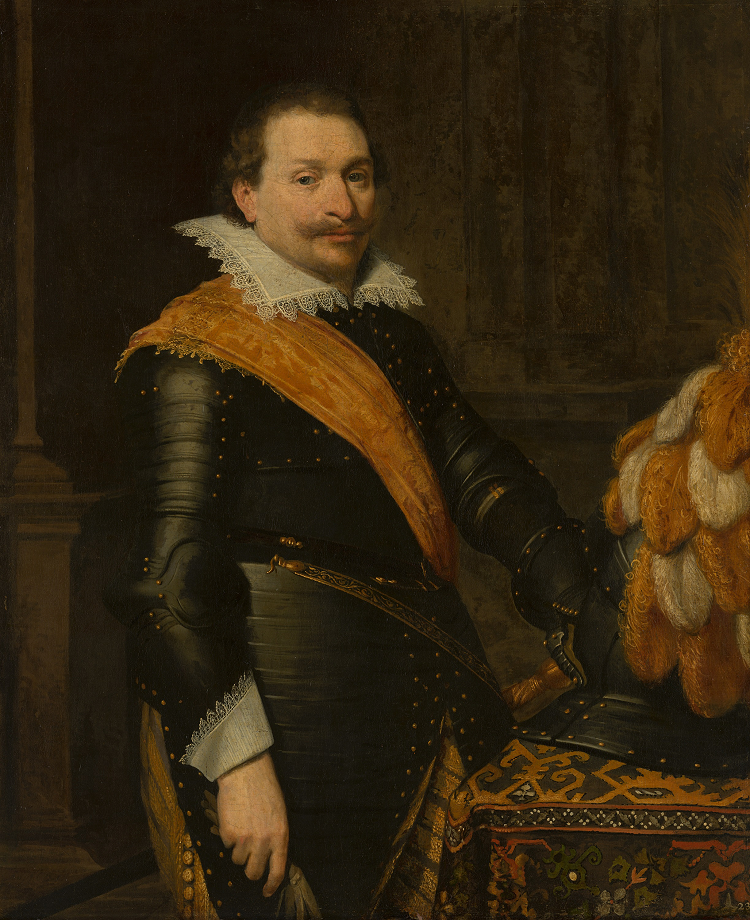One of the most important portrait painters in The Hague at the beginning of the seventeenth century Jan van Ravesteyn, with the help of his studio, painted a series of twenty-five - or twenty-seven, depending on the source; I've included twenty-one here - portraits, portrayals of army officers, soldiers whose commander-in-chief was Prince Maurits of Orange,
stadtholder of all the provinces of the Dutch Republic (with the exception of Friesland) by the time of his death in 1625.
 |
| Possible portrait of Gaspard de Coligny. |
All portrayed in the same general format, three-quarter length, the men are dressed in armor, and across their chest - or tied to their arm - is an orange silk sash, while most of their helmets are lavishly decorated with plumes of the same color, the color of the house of Orange-Nassau.
 |
| Possible portrait of Adolf van Meetkerken. |
 |
| Portrait of Daniel de Hertaing. |
 |
| Portrait of Nicolaas Schmelzing. |
 |
| Portrait of Johann VIII, Count of Nassau-Siegen. |
 |
| Portrait presumed to be of Anthonis van Utenhoven. |
 |
| Possible portrait of Walraven IV van Brederode - or his nephew (or younger brother?) Johann Wolfert van Brederode. |
Commissioned by Prince Maurits, the paintings hung in Huis Honselaarsdijk during the seventeenth century and are now part of the Mauritshuis collection.
 |
| Huis Honselaarsdijk and park in 1620, before its transformation. |
Lying about 2.6 km (2 miles) southwest of The Hague, Huis Honselaarsdijk was one of the finest examples of Baroque architecture in The Netherlands. There had been a small castle on the land since the middle ages. Bought - or merely appropriated - from a count of Arenberg, by 1612 it was the property of Prince Maurits' half-brother, Frederik Hendrik, and used as a hunting lodge and country home. Even before he succeeded Maurits in 1625, Frederik Hendrik had begun work to transform the property. The old building would be pulled down and a new palace - Paleis Honselaarsdijk - built. The building and grounds were designed in the French style - Frederik Hendrik was half French - and construction and reconstruction continued until 1646. The site was famous in its day for its beauty, even called
Klein Versailles by contemporaries.
But later generations didn't always appreciate its charms. And after subsequent lengthy disputes over inheritance and many years of neglect and decay, it was demolished in 1815.
 |
| Circa 1683. |
Jan Anthonisz van Ravesteyn (1572?, Culemborg or The Hague - buried 21 June 1657, The Hague), portrait painter to the Dutch court in The Hague. It's unknown where and by whom he learned his craft, but he was a follower of the Delft portrait painter Michiel Jansz van Mierevelt. From 1598 until his death he lived in the Hague. On moving to The Hague, he became a member of the Guild of St. Luke; in the last year of his life, joining with a group of dissatisfied painter friends, he left the guild and was one of the founders of the Confrerie Pictura. During his long career he and his workshop produced many portraits for the royal house of Orange-Nassau and he was also teacher to many later prominent painters.





































This is absolutely spectacular. Thanks so much.
ReplyDelete